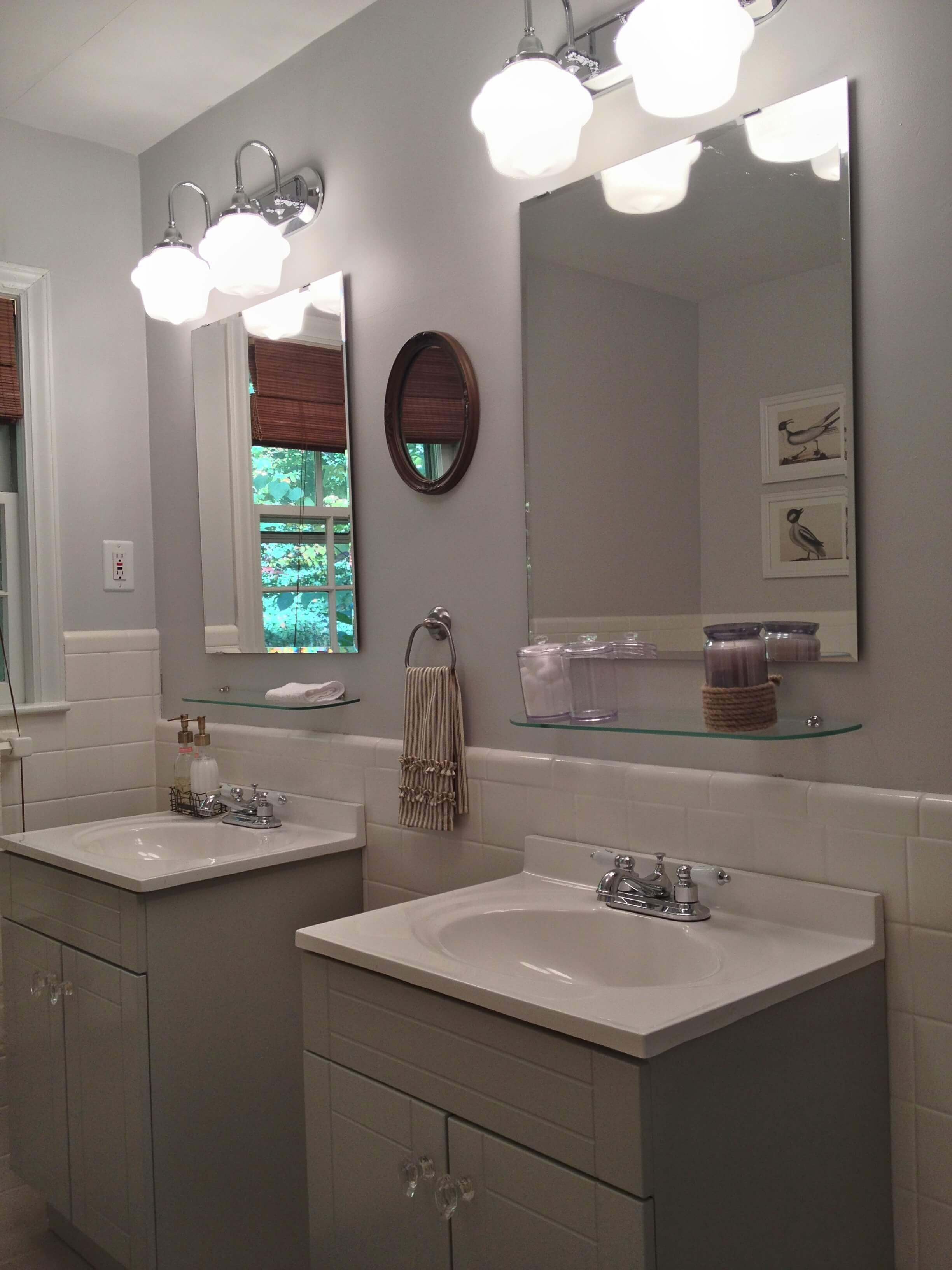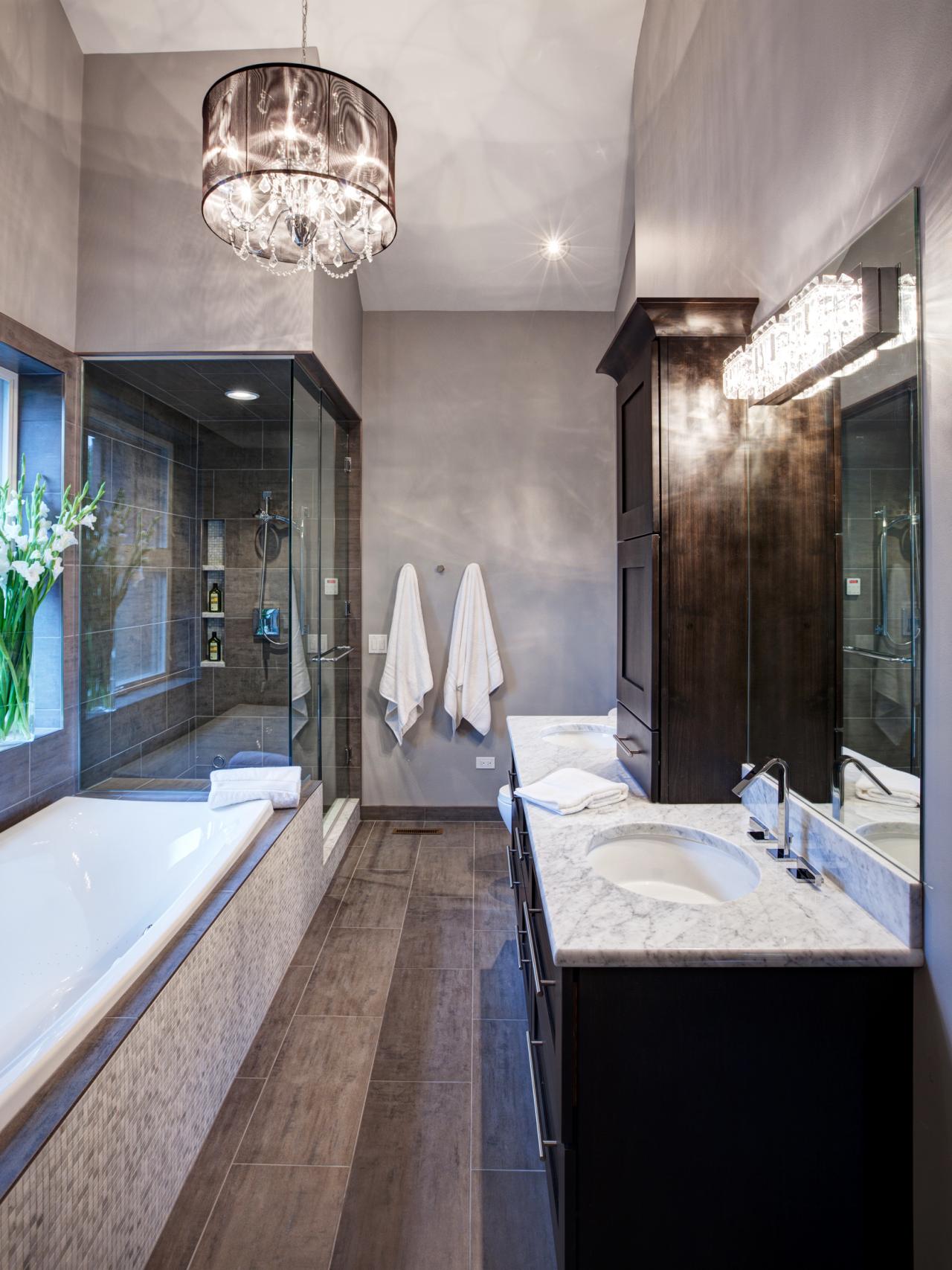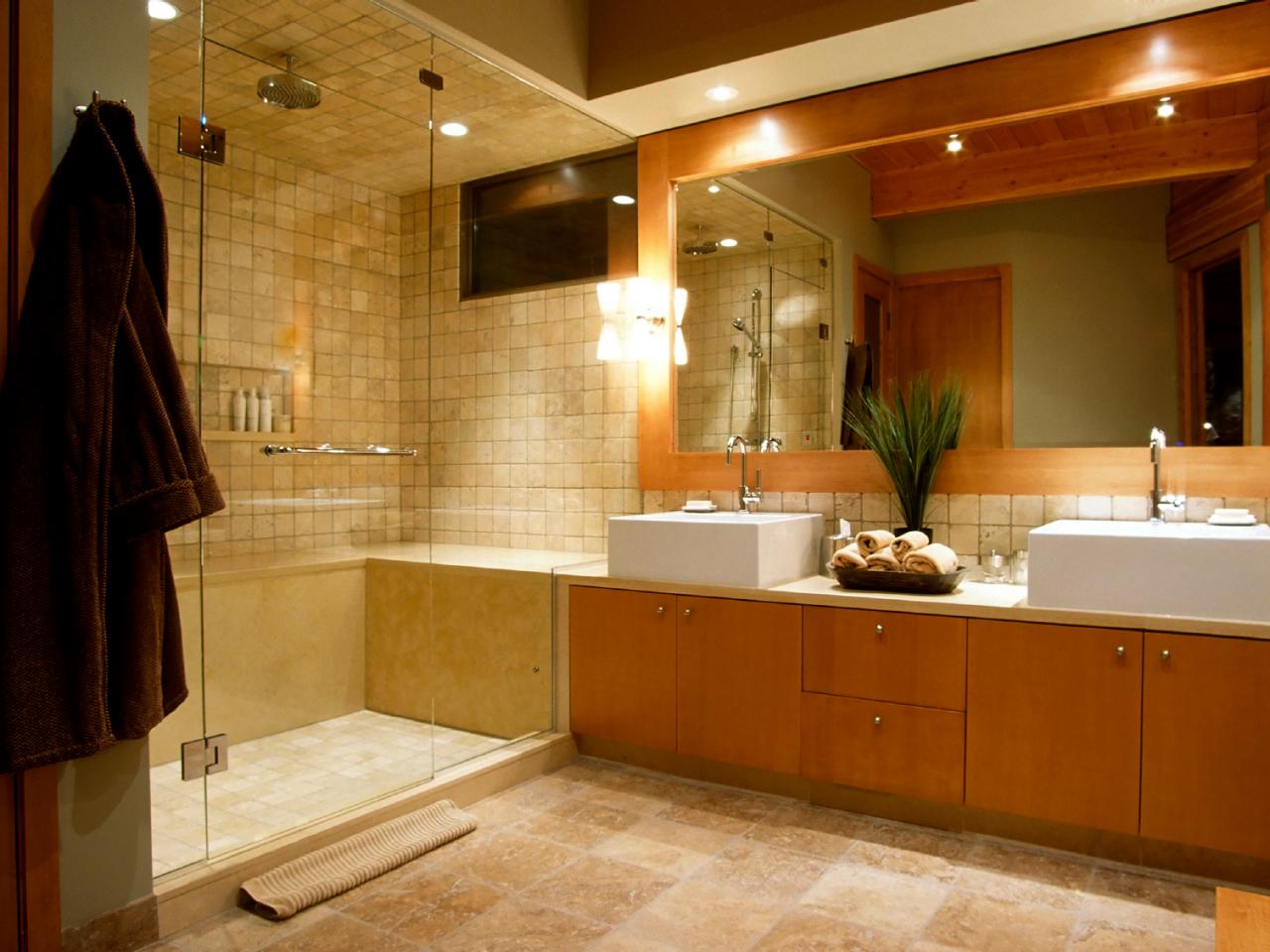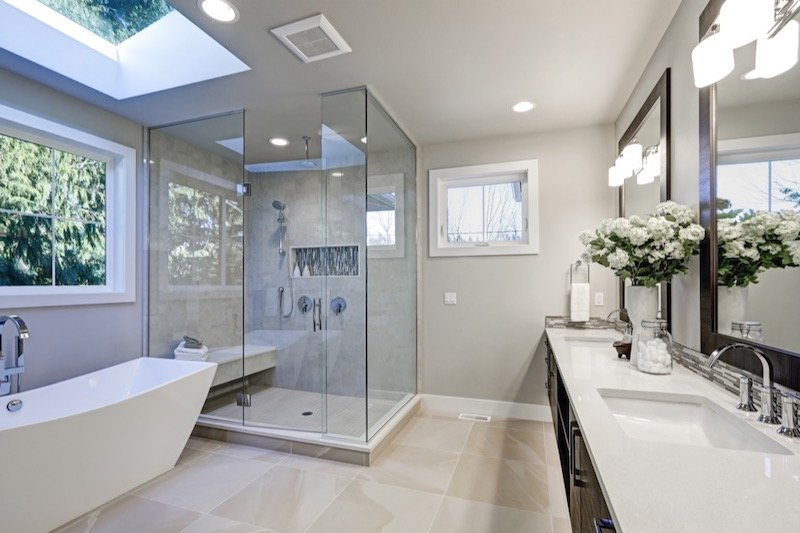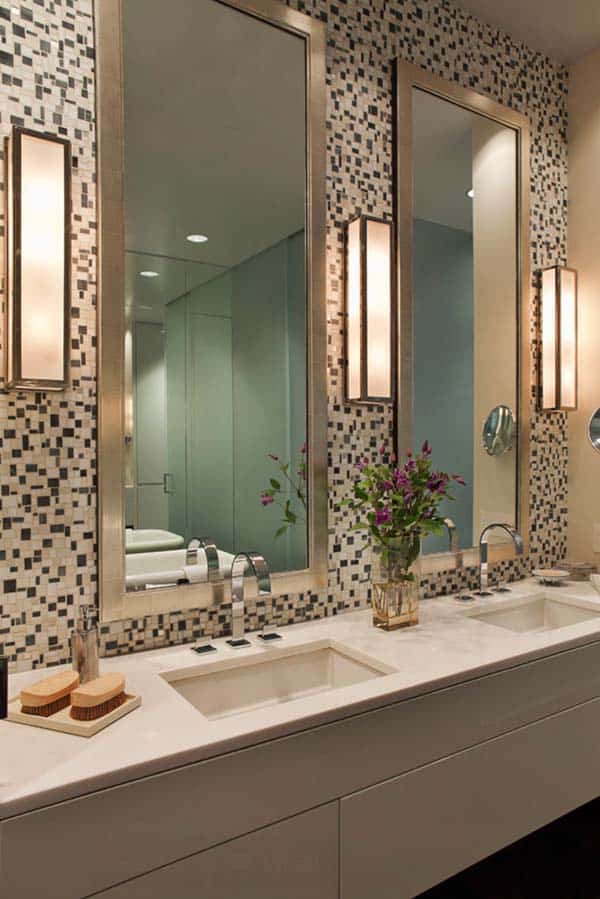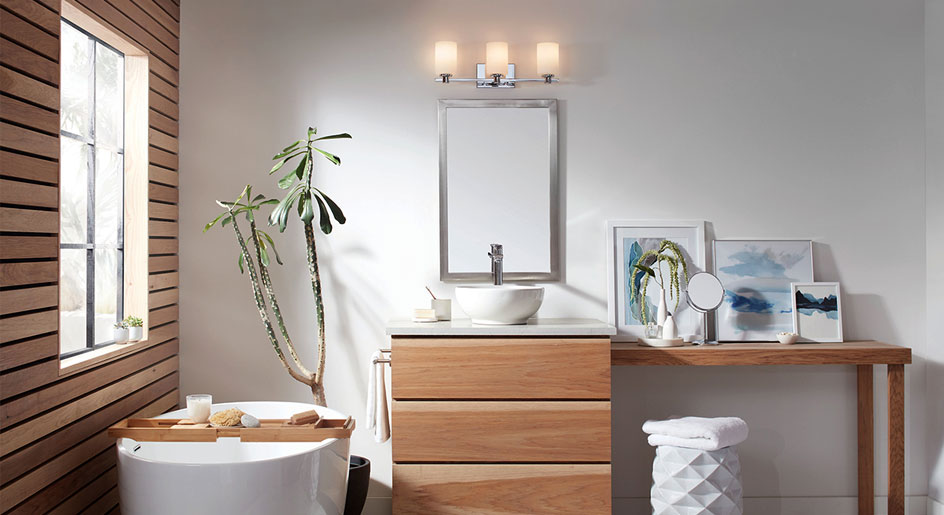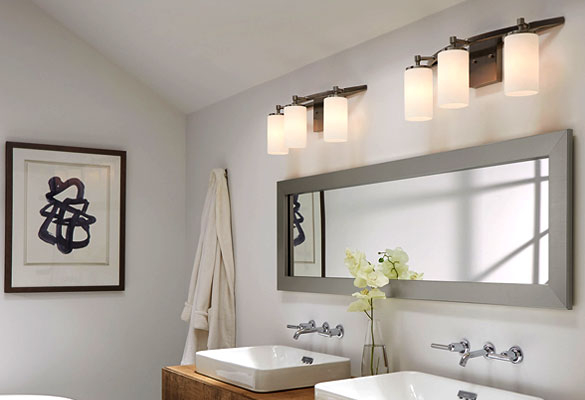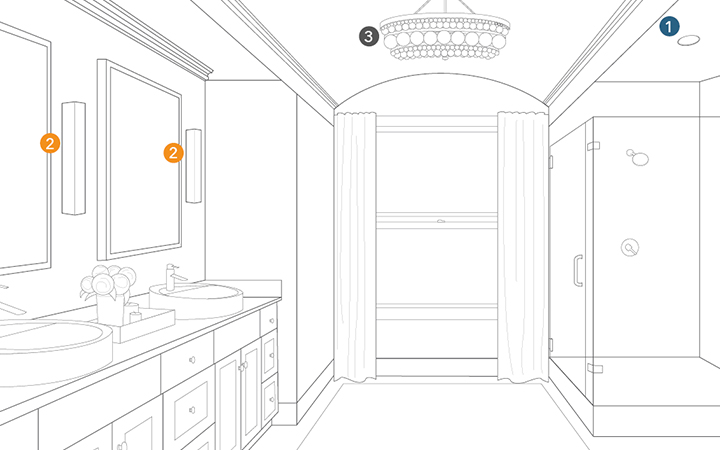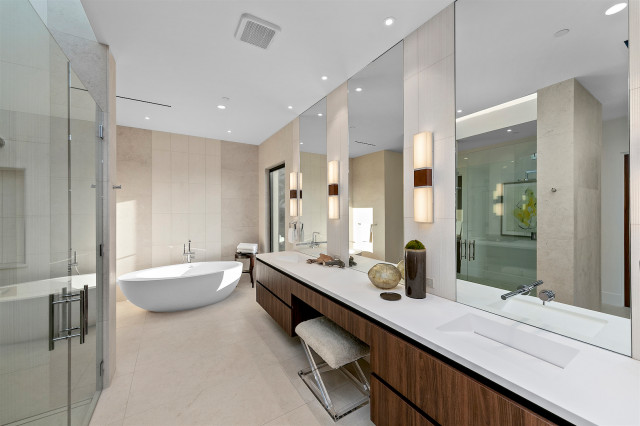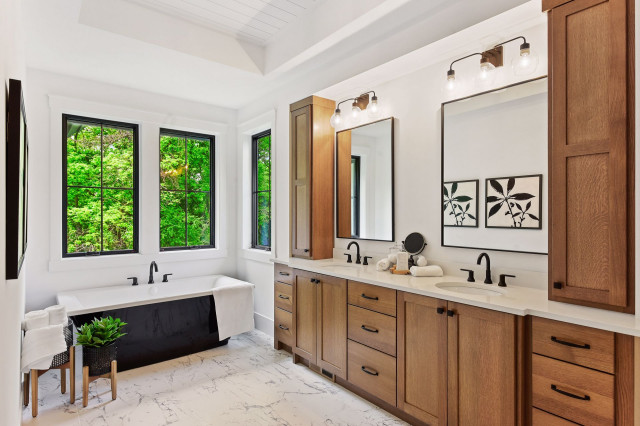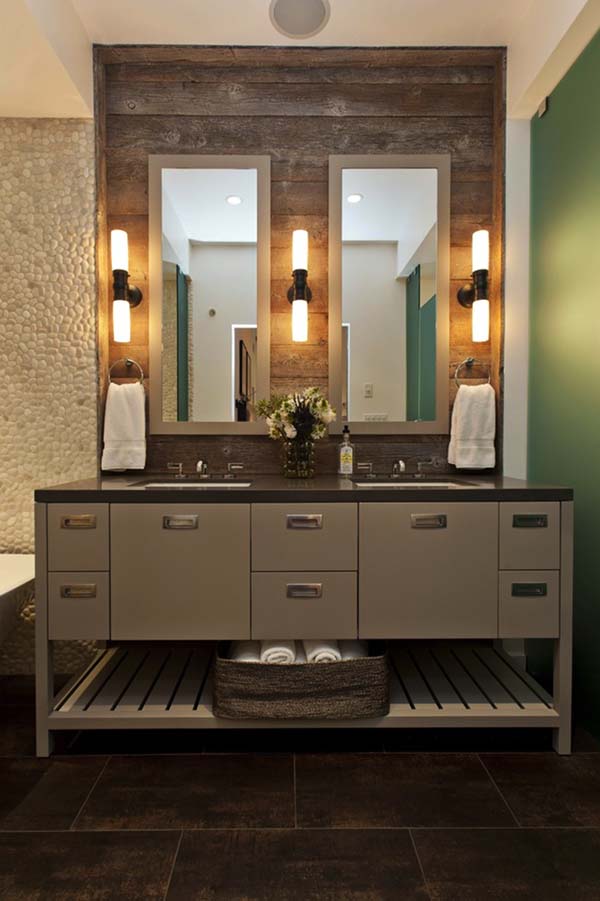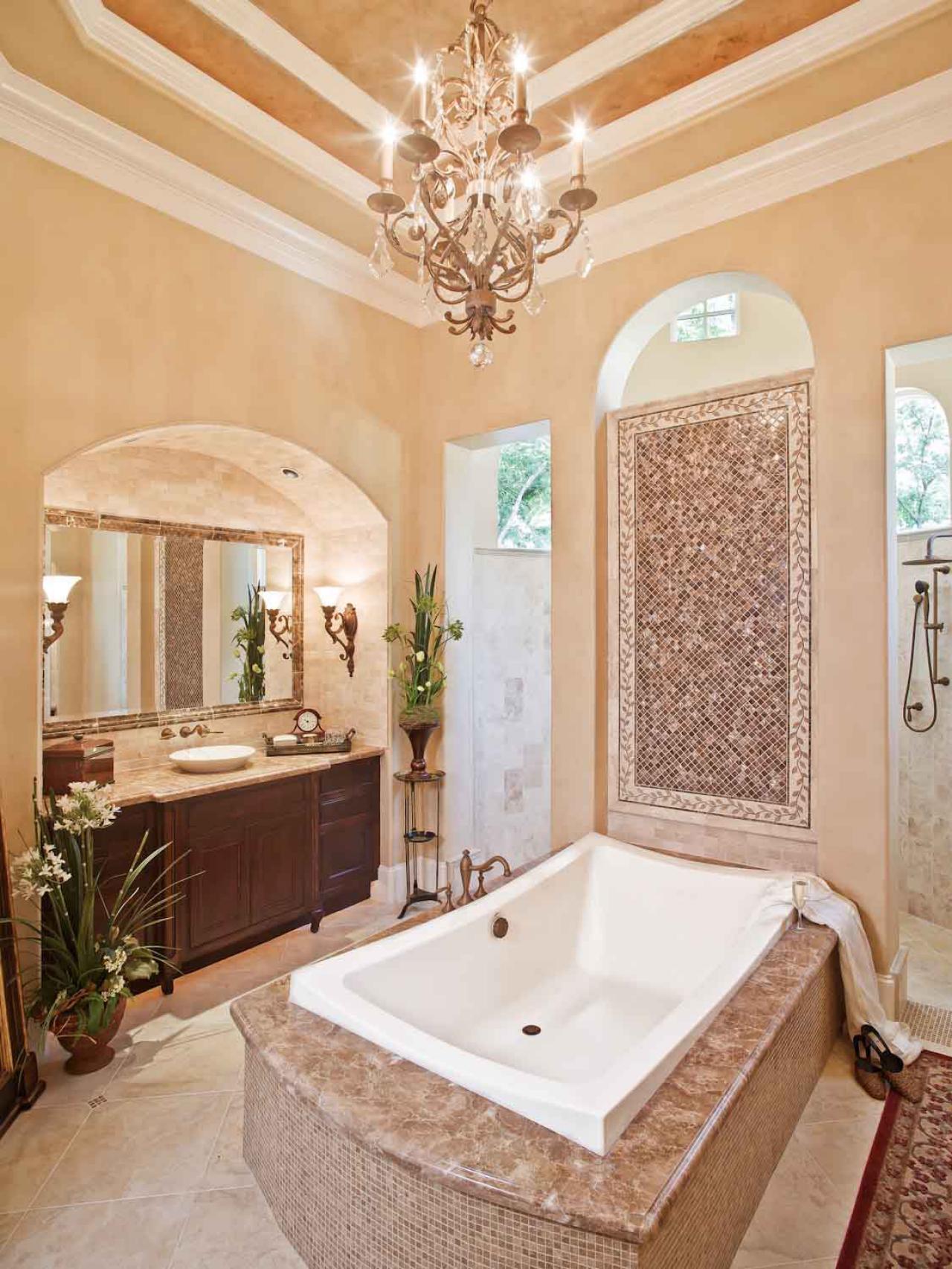Introduction to Bathroom Lighting
Bathroom lighting isn’t just about brightening up the space; it’s about creating a sanctuary where functionality meets aesthetics. From enhancing visibility to elevating the ambiance, the right lighting can transform your bathroom into a luxurious retreat. Here’s everything you need to know to light up your space effectively:
-
Understanding the Layers of Light:
- Ambient Lighting: Sets the overall mood and provides general illumination.
- Task Lighting: Offers focused light for activities like shaving or applying makeup.
- Accent Lighting: Highlights architectural features or décor elements, adding depth to the space.
-
Modern Bathroom Evolution:
- Bathrooms are no longer just functional; they’re spaces for relaxation and rejuvenation.
- Lighting solutions need to balance practicality and style to create a luxurious retreat.
-
Energy-Efficient Options:
- LED lights offer versatility and long-term savings, perfect for modern bathroom designs.
- Smart lighting systems provide customization and control, enhancing the user experience.
-
Choosing the Right Fixtures and Bulbs:
- Consider factors like color temperature, lumens, and Color Rendering Index (CRI) for a cohesive lighting scheme.
- These technical aspects are crucial for achieving flattering lighting that complements both the space and skin tones.
-
Safety Concerns:
- Given the proximity to water, it’s essential to choose fixtures that meet specific safety standards.
- Look for fixtures with appropriate IP ratings to ensure protection against moisture and prevent electrical hazards.

Types of Bathroom Lighting
Ambient Lighting
Ambient lighting serves as the foundation of a bathroom’s illumination. It provides overall light that fills the space, ensuring basic visibility. This type of lighting is usually achieved through ceiling-mounted fixtures, such as recessed lights, flush mounts, or even chandeliers, depending on the bathroom’s size and style.
Recessed Lighting: Also known as can lights, recessed lighting is popular for its unobtrusive nature. These fixtures are installed into the ceiling, providing a clean look while evenly distributing light. They are particularly effective in bathrooms with low ceilings or for a minimalist aesthetic. However, they require careful placement to avoid shadows and ensure even lighting across the room.
Flush Mount Fixtures: These are mounted directly to the ceiling and are a good option for small to medium-sized bathrooms. They come in various designs and styles, from simple to ornate, allowing them to complement different decor themes. Flush mount fixtures are generally easier to install and maintain compared to recessed lighting.
Chandeliers: For a touch of luxury, chandeliers can be used in larger bathrooms. While they are more commonly associated with living rooms and dining areas, bathroom chandeliers add a focal point and a sense of elegance. They work best in bathrooms with high ceilings and require careful consideration of size and style to ensure they do not overwhelm the space.
Task Lighting
Task lighting is essential for activities that require focused light, such as shaving, applying makeup, or brushing teeth. It is typically provided by fixtures placed around mirrors or over specific areas like vanity tables.
Vanity Lighting: Vanity lights can be mounted above or alongside mirrors to eliminate shadows on the face, providing clear and even illumination. Fixtures can be in the form of sconces or bar lights, often equipped with multiple bulbs to spread light evenly. The placement and type of bulb are critical to avoid glare and achieve the desired brightness.
Mirror Lights: Integrated mirror lights are another effective solution, with LED strips or bulbs built into the mirror itself. These provide even light distribution and a sleek, modern appearance. They are ideal for streamlined, contemporary bathroom designs and often include features like dimming or color temperature adjustments.
Pendant Lights: Hanging pendant lights can serve as task lighting over vanity areas. They provide focused illumination and add a decorative element. However, they need to be hung at the correct height to be effective and safe, ensuring they do not obstruct movement or cast unflattering shadows.
Accent Lighting
Accent lighting enhances architectural features and adds a layer of interest to the bathroom. It is used to highlight design elements or create a specific mood.
Cove Lighting: Installed in recessed areas or ledges, cove lighting creates a soft, indirect glow that adds depth and dimension to the bathroom. It is often used around ceilings, behind mirrors, or along bathtub surrounds. Cove lighting is subtle and can enhance the feeling of space and serenity.
Niche Lighting: Ideal for highlighting built-in niches or shelves, niche lighting showcases decorative items or adds functional light to storage areas. Small LED fixtures or strips are commonly used for this purpose. They provide targeted illumination and can make storage areas more accessible.
Under-Cabinet Lighting: Installing lights beneath cabinets or counters can illuminate workspaces and add a modern touch. These are especially useful in larger bathrooms with ample storage and counter space. Under-cabinet lighting is practical for both ambient and task purposes, making it a versatile option.
Decorative Lighting
Decorative lighting adds a stylistic flair to the bathroom, functioning as both illumination and ornamentation. It enhances the decor and contributes to the room’s overall theme.
Wall Sconces: Wall sconces come in a variety of designs, from traditional to contemporary. They can be used to frame mirrors or artwork, adding symmetry and style. Sconces provide both functional and decorative lighting, making them a popular choice for bathrooms.
Ceiling Fixtures: Beyond chandeliers, decorative ceiling fixtures like drum lights or pendant clusters can serve as statement pieces. They should be chosen to match the bathroom’s decor and scale, ensuring they complement rather than overpower the space.
Lighted Mirrors: Mirrors with built-in lighting are both practical and decorative. They combine the functions of a mirror and a light source, providing a sleek solution for modern bathrooms. Lighted mirrors are available in various shapes and sizes, often with features like touch controls and anti-fog capabilities.
Natural Lighting
Natural lighting should not be overlooked as it provides a fresh, dynamic quality to the bathroom. Proper use of windows and skylights can significantly enhance the space.
Windows: Strategically placed windows allow natural light to flood the bathroom, creating a bright and airy feel. They should be designed to maintain privacy while maximizing light. Frosted glass, window treatments, or high placement can balance light and privacy needs.
Skylights: Skylights are excellent for introducing natural light into bathrooms, especially in spaces where wall windows are limited. They can be fixed or vented, with the latter offering ventilation benefits as well. Skylights bring in natural light from above, reducing shadows and providing a more uniform light quality.
Solar Tubes: For bathrooms without direct access to outside walls or roofs, solar tubes provide an innovative solution. These tubular daylighting devices capture sunlight and channel it into the bathroom through a reflective tube. They are efficient and can brighten up interior spaces without requiring major structural changes.
Placement and Layering of Bathroom Lighting
Vanity Area
The vanity area requires careful lighting to ensure tasks like shaving or makeup application are performed effectively. Proper placement of lights around the mirror eliminates shadows and provides even illumination.
Above Mirror: Placing lights above the mirror is a common approach. A horizontal light bar or multiple fixtures can provide ample light. The key is to position the fixture at eye level or slightly above to reduce shadows on the face.
Side Mirrors: Installing lights on either side of the mirror, at about face height, offers balanced lighting that minimizes shadows. Sconces or vertical light bars are suitable for this purpose. This setup is particularly effective for tasks that require detailed work.
Integrated Mirror Lights: Mirrors with built-in lighting provide an even and shadow-free illumination. They are ideal for modern bathrooms with a minimalist design. The light source is often placed around the edges of the mirror, providing a clear and unobstructed view.
Shower and Bathtub Areas
Lighting in shower and bathtub areas must be both functional and safe. These areas benefit from dedicated lighting that enhances visibility while maintaining a soothing atmosphere.
Recessed Lighting: Waterproof recessed lights are a practical choice for shower areas. They provide focused light without compromising safety. Placement should ensure that the light covers the entire shower area, avoiding dark spots.
Pendant Lights: Hanging lights can add a decorative element over bathtubs, creating a spa-like ambiance. However, they must be positioned high enough to comply with safety regulations and to prevent moisture damage.
LED Strips: Flexible LED strips can be used around bathtubs to create a soft, indirect light. They are often placed under the lip of the tub or along the base, providing a gentle glow that enhances relaxation.
General Ceiling Lighting
General ceiling lighting ensures overall illumination for the entire bathroom. It should be bright enough for visibility but not harsh, contributing to a welcoming environment.
Central Fixtures: A central ceiling fixture, such as a flush mount or chandelier, provides a focal point and general lighting. It should be complemented by other light sources to avoid a flat, one-dimensional look.
Multiple Recessed Lights: Using several recessed lights spaced evenly across the ceiling offers uniform lighting. This method reduces shadows and provides consistent light throughout the bathroom.
Adjustable Fixtures: Fixtures with adjustable heads or track lighting can be directed to specific areas, offering flexibility in lighting design. They allow for customization and can highlight particular features or provide additional light where needed.
Accent and Decorative Placement
Accent and decorative lights add personality and highlight architectural elements or decor. Their placement should be strategic to enhance the bathroom’s design without overwhelming the space.
Shelving and Niches: Lights installed in shelving or niches draw attention to decorative items or provide functional lighting for storage. They add depth and interest to the bathroom design.
Under-Cabinet: Placing lights under cabinets or counters offers practical illumination for workspaces and contributes to a modern look. They are particularly useful in larger bathrooms with ample cabinetry.
Highlighting Features: Decorative lights can be used to accentuate features like artwork, architectural details, or statement fixtures. Their placement should be considered carefully to balance aesthetics and functionality.
Natural Light Integration
Integrating natural light enhances the bathroom environment, creating a connection with the outdoors and reducing the need for artificial lighting during the day.
Window Placement: Positioning windows to capture maximum light while maintaining privacy is essential. High or frosted windows provide natural light without compromising seclusion.
Skylights and Tubes: Skylights and solar tubes introduce light from above, illuminating the bathroom uniformly. They are ideal for interior bathrooms without wall windows or for enhancing existing natural light sources.
Light Control: Using window treatments, like blinds or shades, allows control over the amount of natural light entering the bathroom. This flexibility helps in maintaining comfort and privacy at different times of the day.
Bulbs and Fixtures
Choosing the Right Bulbs
Selecting the appropriate bulbs is critical for achieving the desired lighting effect and ambiance. Factors like color temperature, brightness, and energy efficiency influence the overall lighting quality.
Color Temperature: Measured in Kelvin (K), color temperature determines the warmth or coolness of the light. Warm light (2700K-3000K) is suitable for creating a cozy atmosphere, while cool light (4000K-5000K) provides a more clinical and vibrant illumination, ideal for task areas.
Lumens: Lumens measure the brightness of a bulb. Higher lumens mean brighter light. For bathroom lighting, a range of 500-800 lumens is generally adequate for ambient light, while 800-1200 lumens is suitable for task lighting.
CRI (Color Rendering Index): CRI measures how accurately a light source renders colors. A higher CRI (80-90) is preferable for bathroom lighting as it provides more accurate color representation, important for tasks like applying makeup.
Fixture Styles
Choosing fixtures involves balancing style, function, and compatibility with the bathroom’s decor. Fixtures should complement the overall design while fulfilling their lighting purpose.
Contemporary Fixtures: Sleek and minimalistic, contemporary fixtures suit modern bathrooms. They often feature clean lines and metallic finishes, providing a streamlined appearance that integrates well with minimalist designs.
Traditional Fixtures: Traditional fixtures have ornate details and classic finishes like brass or bronze. They are ideal for bathrooms with a vintage or classic theme, adding a touch of elegance and timeless appeal.
Industrial Fixtures: Industrial-style fixtures feature raw, unfinished looks, often incorporating materials like metal and exposed bulbs. They add a rugged charm and are perfect for urban or eclectic bathroom designs.
Energy Efficiency
Energy-efficient lighting is essential for reducing power consumption and environmental impact. Modern options offer significant energy savings without compromising on light quality.
LED Bulbs: LED bulbs are the most energy-efficient option, consuming up to 80% less energy than incandescent bulbs. They have a long lifespan and are available in various color temperatures and styles, making them suitable for all bathroom lighting needs.
CFL Bulbs: Compact Fluorescent Lamps (CFLs) are more energy-efficient than traditional incandescent bulbs but less so than LEDs. They provide a softer light and are a cost-effective option for bathroom lighting.
Smart Bulbs: Smart bulbs offer advanced features like remote control, dimming, and color changing through smartphone apps. They provide energy efficiency and convenience, allowing for customization of lighting settings.
Fixture Installation
Proper installation of fixtures ensures they function correctly and safely. Professional installation is often recommended, especially for complex setups or where electrical work is involved.
Placement Accuracy: Accurate placement is crucial for achieving the desired lighting effect. Fixtures should be positioned to avoid shadows and glare while providing adequate illumination for specific areas.
Safety Considerations: Adhering to safety standards is essential, particularly in wet areas like showers. Fixtures must have appropriate IP ratings to withstand moisture and prevent electrical hazards.
Wiring and Support: Ensuring fixtures are properly wired and supported is vital for their longevity and safety. Professional installation helps in avoiding potential issues like short circuits or structural failure.
Maintenance and Upkeep
Regular maintenance ensures that bathroom lighting remains effective and safe. Cleaning fixtures and replacing bulbs as needed prevents deterioration of light quality and fixture appearance.
Cleaning: Fixtures should be cleaned periodically to remove dust and grime that can diminish light output. Use appropriate cleaning agents and techniques to avoid damaging finishes or electrical components.
Bulb Replacement: Replacing bulbs promptly when they burn out maintains consistent lighting. Using bulbs with similar specifications ensures uniform light quality and appearance.
Inspection: Regularly inspecting fixtures for signs of wear or damage helps in identifying issues early. Addressing problems like loose connections or moisture ingress promptly prevents potential hazards.
Safety Considerations
IP Ratings
IP (Ingress Protection) ratings indicate the level of protection fixtures have against moisture and dust. Understanding IP ratings is essential for selecting appropriate fixtures for different bathroom zones.
Understanding IP Ratings: The first digit of the IP rating represents protection against solids, while the second digit indicates protection against liquids. For example, an IP44 rating means protection against solid objects larger than 1mm and water splashes from any direction.
Wet Areas: Fixtures in wet areas like showers should have a higher IP rating (IP65 or above) to ensure they are adequately protected against water jets and steam. This prevents water ingress and reduces the risk of electrical hazards.
Damp Areas: Fixtures in damp areas, such as near sinks or above bathtubs, can have a lower IP rating (IP44). They should still provide sufficient protection against splashes and humidity.
Electrical Safety
Ensuring electrical safety is paramount in bathroom lighting. Proper installation and adherence to safety guidelines prevent accidents and electrical hazards.
Grounding: All fixtures should be properly grounded to prevent electrical shocks. Grounding provides a safe path for electricity in case of a fault, reducing the risk of injury.
GFCI Protection: Ground Fault Circuit Interrupters (GFCIs) are essential for outlets and lighting circuits in bathrooms. They detect electrical imbalances and shut off power to prevent electric shocks.
Professional Installation: Hiring a licensed electrician for installation ensures compliance with electrical codes and standards. Professional installation reduces the risk of wiring issues and other electrical problems.
Fixture Selection
Choosing the right fixtures involves considering both functionality and safety. Fixtures should be suitable for the bathroom environment and meet safety standards.
Moisture Resistance: Fixtures in bathrooms should be resistant to moisture to prevent corrosion and electrical hazards. Using fixtures with appropriate IP ratings and moisture-resistant materials ensures longevity and safety.
Heat Resistance: Fixtures should also be heat-resistant, particularly in areas where steam or high temperatures are common. Heat-resistant materials prevent warping or damage over time.
Secure Mounting: Fixtures should be securely mounted to prevent them from falling or becoming dislodged. Proper mounting techniques and hardware ensure stability and safety.
Bulb Safety
Choosing and handling bulbs safely is crucial for preventing accidents and maintaining proper lighting. Using appropriate bulbs and following safety guidelines ensures effective and safe illumination.
Appropriate Wattage: Using bulbs with the correct wattage for fixtures prevents overheating and potential fire hazards. Always follow manufacturer recommendations for bulb wattage.
Handling Bulbs: Handle bulbs with care, particularly halogen or incandescent bulbs, which can get very hot. Allow bulbs to cool before replacing them to avoid burns.
Disposal: Dispose of old or damaged bulbs properly, following local guidelines for recycling or disposal. Some bulbs, like CFLs, contain hazardous materials and require special handling.
Regular Maintenance
Regular maintenance ensures fixtures remain safe and effective. Inspecting and maintaining lighting systems prevents potential hazards and prolongs the life of fixtures.
Inspection: Periodically inspect fixtures for signs of damage or wear. Look for loose connections, moisture ingress, or other issues that could compromise safety.
Cleaning: Clean fixtures regularly to prevent the buildup of dust and grime, which can affect performance and safety. Use appropriate cleaning methods to avoid damaging fixtures or electrical components.
Replacement: Replace fixtures or bulbs promptly when they show signs of failure or damage. Using compatible and high-quality replacements ensures continued safety and effectiveness.
Common Mistakes to Avoid in Bathroom Lighting
Ignoring IP Ratings
One of the most common mistakes in bathroom lighting is neglecting the importance of IP ratings. Fixtures without appropriate IP ratings for their location can suffer from moisture damage, leading to electrical hazards and reduced lifespan.
Wet Areas: Installing fixtures with insufficient IP ratings in wet areas like showers or near bathtubs can result in water ingress and potential electrical faults. Always choose fixtures with high IP ratings (IP65 or above) for these areas.
Damp Areas: Even in less exposed areas, like near sinks or mirrors, using fixtures with low IP ratings can lead to corrosion and malfunction. Opt for at least IP44-rated fixtures in damp areas.
Understanding Ratings: Misinterpreting IP ratings can lead to inappropriate fixture choices. Ensure you understand what each digit represents and choose fixtures accordingly to meet the protection needs of specific bathroom zones.
Overlooking Task Lighting
Another mistake is neglecting adequate task lighting, which is crucial for activities like shaving, makeup application, or hair styling. Insufficient task lighting can lead to poor visibility and an increased risk of errors during these tasks.
Mirror Lighting: Failing to install proper lighting around mirrors can result in shadows and uneven illumination. Place lights on either side or above mirrors to provide clear and even lighting for the face.
Incorrect Placement: Task lighting that is too high or too low can create unflattering shadows or fail to provide adequate light where needed. Position fixtures at or near eye level for the best results.
Using General Lighting: Relying solely on general ceiling lighting for task areas can result in insufficient brightness and poor focus. Complement general lighting with dedicated task lights to enhance visibility and functionality.
Choosing Inappropriate Bulbs
Using the wrong bulbs can affect the quality and effectiveness of bathroom lighting. Factors like color temperature, brightness, and energy efficiency must be considered for optimal lighting.
Color Temperature: Using bulbs with the wrong color temperature can create an uncomfortable atmosphere or unflattering light for tasks. Choose warm light (2700K-3000K) for relaxation areas and cooler light (4000K-5000K) for task areas.
Brightness: Insufficient or excessive brightness can make the bathroom uncomfortable or ineffective for specific tasks. Select bulbs with appropriate lumens to match the lighting needs of different areas.
Energy Efficiency: Ignoring energy-efficient options like LEDs can lead to higher energy costs and more frequent bulb replacements. Opt for energy-efficient bulbs to save on electricity and maintenance.
Poor Fixture Placement
Incorrect placement of fixtures can result in uneven lighting, shadows, or glare. Thoughtful placement is essential for achieving balanced and effective lighting.
Shadow Creation: Placing fixtures in positions that create shadows, such as directly above or behind the head, can hinder visibility. Ensure fixtures are placed to provide even and shadow-free lighting.
Glare Issues: Fixtures placed at angles that cause glare can be uncomfortable and reduce visibility. Position lights to avoid direct glare into the eyes, particularly in task areas.
Overcrowding: Too many fixtures can clutter the bathroom and create an overwhelming lighting effect. Balance the number and placement of fixtures to achieve a cohesive and functional lighting scheme.
Neglecting Aesthetic Balance
Focusing solely on functionality without considering aesthetics can lead to a visually unappealing bathroom. Lighting should enhance both the practical and aesthetic aspects of the space.
Mismatch with Decor: Choosing fixtures that clash with the bathroom’s decor can disrupt the overall design. Select fixtures that complement the style and theme of the bathroom.
Ignoring Layers: Relying on a single type of lighting can result in a flat and uninteresting appearance. Use a combination of ambient, task, and accent lighting to create a dynamic and layered lighting effect.
Overlooking Natural Light: Failing to incorporate or control natural light can lead to an unbalanced lighting scheme. Utilize windows, skylights, or solar tubes effectively, and use treatments to control the intensity of natural light.
Why is layering important in bathroom lighting?
Layering in bathroom lighting involves using a combination of ambient, task, and accent lighting to achieve a balanced and effective illumination scheme. Each layer serves a specific purpose:
Ambient Lighting: Provides general illumination for the entire bathroom, ensuring basic visibility and creating an overall sense of brightness. It sets the tone for the room and fills in the spaces between task and accent lights.
Task Lighting: Focuses on specific areas where detailed work is performed, such as vanities or shower areas. Proper task lighting enhances functionality and reduces the risk of errors during activities like shaving or applying makeup.
Accent Lighting: Highlights architectural features, decor, or specific areas, adding depth and interest. It enhances the aesthetic appeal and can create a mood that complements the bathroom’s design.
By combining these layers, you achieve a cohesive and versatile lighting scheme that addresses both practical and aesthetic needs.
What color temperature is best for bathroom lighting?
The best color temperature for bathroom lighting depends on the specific area and its function:
Warm Light (2700K-3000K): Ideal for creating a relaxing and cozy atmosphere. It is suitable for ambient lighting and areas where you want a softer, more comfortable light. Warm light is particularly effective in enhancing the bathroom’s ambiance and creating a spa-like environment.
Neutral Light (3500K-4000K): Provides a balance between warm and cool tones, offering a natural and comfortable illumination. It is versatile and can be used for both ambient and task lighting. Neutral light is often preferred for general bathroom lighting due to its balanced appearance.
Cool Light (4000K-5000K): Best for task lighting areas where clarity and focus are essential, such as vanity mirrors. Cool light provides a bright and vibrant illumination that enhances visibility and color accuracy, making it ideal for detailed tasks.
Choosing the right color temperature involves considering the bathroom’s overall design and the specific lighting needs of different areas.
How can I ensure safety with bathroom lighting fixtures?
Ensuring safety with bathroom lighting fixtures involves several key considerations:
IP Ratings: Select fixtures with appropriate IP ratings for their location. High IP ratings are essential for wet areas like showers to protect against moisture ingress and electrical hazards.
Electrical Safety: Ensure fixtures are properly grounded and that circuits are protected by GFCIs. These measures prevent electrical shocks and provide an added layer of safety in wet environments.
Professional Installation: Hire a licensed electrician for installation, particularly for complex setups or areas requiring waterproof fixtures. Professional installation ensures compliance with electrical codes and standards.
Secure Mounting: Fixtures should be securely mounted to prevent them from falling or becoming dislodged. Proper mounting techniques and hardware ensure stability and safety.
Regular Maintenance: Regularly inspect and maintain fixtures to identify and address potential issues early. Cleaning and replacing bulbs as needed helps maintain safety and effectiveness.
What are the benefits of using LED bulbs in bathroom lighting?
LED bulbs offer several advantages for bathroom lighting:
Energy Efficiency: LEDs consume significantly less energy than traditional incandescent or CFL bulbs, leading to lower electricity bills and reduced environmental impact. They are an eco-friendly choice that contributes to energy conservation.
Longevity: LEDs have a longer lifespan compared to other types of bulbs, reducing the frequency and cost of replacements. They can last for many years, making them a cost-effective option over time.
Versatility: LED bulbs are available in various color temperatures and styles, allowing for flexibility in design and functionality. They can be used for ambient, task, or accent lighting, adapting to different needs and preferences.
Dimming and Control: Many LED bulbs are compatible with dimmers and smart controls, offering the ability to adjust brightness and color temperature to suit different moods and activities.
Heat Reduction: LEDs generate less heat than incandescent bulbs, making them safer to use in enclosed fixtures and reducing the risk of overheating.
How can natural light be effectively incorporated into bathroom lighting?
Incorporating natural light into bathroom lighting enhances the space and reduces reliance on artificial light:
Windows: Strategically place windows to maximize natural light while maintaining privacy. Frosted glass, high placement, or window treatments can balance light and privacy needs.
Skylights: Install skylights to bring in natural light from above, providing a uniform and bright illumination. Skylights are particularly effective for bathrooms with limited wall windows.
Solar Tubes: Use solar tubes to channel sunlight into interior bathrooms without direct access to outside walls or roofs. They are an efficient way to introduce natural light without major structural changes.
Light Control: Employ window treatments like blinds or shades to control the intensity of natural light. This flexibility helps in managing light levels and maintaining comfort throughout the day.
Complementary Artificial Lighting: Combine natural light with artificial lighting to ensure adequate illumination during evening or overcast conditions. This approach provides a balanced lighting scheme that adapts to different times and weather conditions.
Related Posts:
- Kohler Bathroom Light Fixtures
- Art Nouveau Bathroom Lighting
- Bathroom Light And Fan Switch
- How To Remove Round Bathroom Light Cover
- Bathroom Light Sensor Switch Screwfix
- Linear Bathroom Lighting
- Vintage Bathroom Lights Uk
- Bathroom Light Pull Switch Wilkinsons
- Bathroom Lighting Cork
- Bathroom Light Fixture Globes
